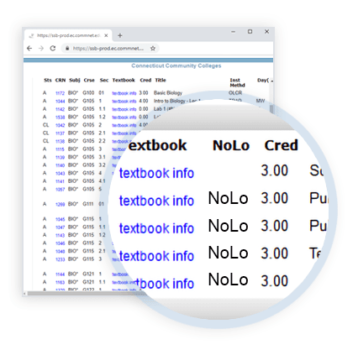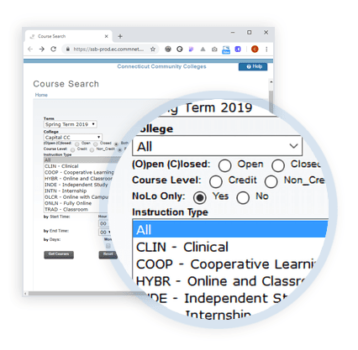 The rising cost of college textbooks has been well-documented over the past few years. Reports indicate that textbook prices have risen by over 800%—three times the inflation rate over the past 50 years, according to the U.S. Bureau of Labor Statistics.
The rising cost of college textbooks has been well-documented over the past few years. Reports indicate that textbook prices have risen by over 800%—three times the inflation rate over the past 50 years, according to the U.S. Bureau of Labor Statistics.
A study from the Florida Virtual Campus documented the academic impact that textbook costs had on student success. The study detailed that 47% of the student population took fewer courses due to the cost of their textbooks, while 66% reported not purchasing a required textbook with 37% of those students earning a poor grade and 19% failing the course.
Some reports suggest textbook spending is on the decline, which may be due to a number of factors including increased use of OER (Open Educational Resources) and volume discount programs dubbed “inclusive access.”
Inclusive access is an automatic billing program where the costs of the textbooks are embedded in the student’s tuition or assessed as an additional course fee. Proponents state that this discount program ensures that all students have access to their required textbooks on the first day of class and at a discounted rate.
The U.S. PIRG Education Fund, however, recently raised concerns regarding price transparency and student choice with this automatic billing process, stating that nearly half of automatic billing agreements in place “fail to fully disclose their discount structure” and two-thirds of the agreements have clauses that reduce or eliminate the discount if enrollment quotas aren’t met.
We must be transparent about the total cost of education in order to give students an opportunity to make informed decisions about which courses and programs fit not only their career goals but also their budgets—and that includes the price of course materials.
In fact, the Higher Education Opportunity Act (HEOA) of 2008 requires it. This law, enacted in 2010, requires institutions to display the “retail price information of required and recommended college textbooks and supplemental materials for each course,” including “alternate content delivery programs” and “cost-saving strategies.”
OER would clearly land within the “cost-savings strategies” of HEOA, but institutions don’t always have an easy way to disclose to their students which courses are utilizing OER. The HEOA calls on college bookstores to collect and display textbook adoption information. In some cases, the adopted OER materials are never reported; in other cases, the bookstore displays a message for the students to review the course syllabus for required materials. Even when the OER material is listed and fulfilled by the bookstore, students don’t have a clear view of which courses are using low-cost or no cost-materials until they visit the bookstore website. For a student purposefully seeking a low-cost option, one may have to click through several sections of the same course to find which section might be using OER.
Course designators
Institutions, systems and states seeking to increase transparency and the visibility of low-cost course options have adopted “course designators,” within the course schedule to signal which courses use OER or low-cost course materials. Course designators can be text-based or image-based labels that clearly denote which course sections have these options available: OER (free and openly licensed), No-Cost (free but not necessarily open), and Low-Cost (falling under a cost-cap that may range from $25-$50 and possibly including commercial materials). Additionally, the search interface allows users to search and filter for these course designators, increasing the chances for student discovery.
By marking which course sections have adopted no-cost or low-cost options, institutions also have greater insight into the adoption rate of these materials as well as projected cost savings/cost avoidance from traditional commercial materials.
Several price transparency efforts can be connected to Achieving the Dream’s (AtD) OER Degree Initiative and its requirement to clearly label which courses within a program use OER materials.
Connecticut course markings
Within the Connecticut State Colleges & Universities system (CSCU), our labeling efforts also started with an AtD grant. Housatonic Community College, located in Bridgeport, Conn., received a grant to develop a Z-degree (zero textbook cost) Associate in General Studies. As part of the grant requirements, Housatonic marked those courses within the program by appending “OER” to the course title within the course registration system. Jennifer Nohai-Seaman, the coordinator of Housatonic’s AtD OER Degree Initiative, stated that “our goals were twofold. We wanted to let students know that these courses had OER materials, which meant that they were saving some money and that they could take an entire degree of courses that are OER. Secondly, it was also to advertise to other faculty that they, too, could join the OER movement at Housatonic, and have their courses marked OER.”
Capital Community College, located in Hartford, Conn., implemented a similar approach to marking courses using no-cost or low-cost course materials by appending #NOLO to their course titles. Eileen Rhodes, director of library services at Capital, noted that “the main factor from the student perspective in purchasing textbooks is cost, so we wanted to highlight that issue by creating a designator that included that concept. To label OER would require additional education on the part of the college staff to ensure students understood what OER meant. The designator not only encompasses OER but also includes other low-cost alternatives [such as] library resources. The goal was to create a memorable designator that would be short in characters (to fit in the allotted character space in the student information system) and also be descriptive and appealing to students so that we could build a marketing campaign around the concept, and ideally, cost transparency for students.”
Implementation
In December 2017, the CSCU system formed a systemwide OER Advisory Council to explore best practices for OER awareness and adoption. To assist in greater faculty and institutional adoption as well as improve data capture, the CSCU OER Advisory Council made a formal recommendation to the provost’s academic council in spring 2018 to implement the #NOLO designator as a course section attribute within the student information system. Besides adding a course section attribute, CSCU introduced a student-facing course search filter as well as a new column within the course search results page that displayed which sections were designated as NOLO.


For fall 2019, CSCU had 700+ sections across 10 of its 17 institutions listed as NOLO.
Lessons Learned
Given how quickly our effort went from recommendation to implementation, there were certainly some areas that needed more attention. While there was buy-in from system-level executives and institutional academic leadership, we could have spent more time discussing the benefits of price transparency and the criteria of the course designator with our faculty constituents and our course schedulers.
Without that refined messaging on the benefits of NOLO and price transparency, one recurring faculty concern was that these price transparency efforts would harm enrollment of non-participating faculty. Since each institution determines whether to opt-in to our NOLO effort, some faculty senates voted against adopting the NOLO course designator.
Thankfully, the CSCU Institutional Research team was able to address those enrollment concerns. Reporting on the fall 2019 semester, two trends emerged: One, there was no significant impact on overall enrollment including first-to-fill or waitlisting. Two, for courses where any section utilized the NOLO designator, the majority of those other course sections also identified as NOLO.
Fall 2019 enrollment data
Across all 12 Connecticut community college’ courses (not sections):
- 126 courses (3%) of 4,139 courses offered have at least one section with a NOLO attribute
- 98 (78%) of those 126 courses have all associated sections marked as NOLO
- 28 (22%) of those 126 courses have a mix of NOLO and non-NOLO sections
- As of 9/27/2019, 4,643 seats are filled in those 126 courses
- 2,797 seats (60%) are in courses where all sections are marked as NOLO
- 1,846 seats (40%) are in courses where there was a choice between NOLO and non-NOLO sections
While the reporting focuses solely on the community colleges, a typically cost-sensitive student body, we still do not see a major impact on enrollment based on labeling. Student surveys performed as part of our fall 2019 OER grant program also emphasize that labeling wasn’t the sole driver for most students enrolling in a specific NOLO section; other factors, such as schedule, course sequence in major, and instructor, also were weighed. Cost and price transparency are still critical components, especially for students in need.
Efforts are currently underway to evaluate the spring 2020 semester and determine the percentage of Pell-eligible students taking advantage of the NOLO sections.
One more area that needs attention is our communication with the bookstore. While not directly connected to the process of labeling courses, the manner in which the bookstore is displaying, pricing and fulfilling materials requests has caused some hiccups. First let me state that we must be diligent in reporting all course materials, including OER, to the bookstore. HEOA makes this requirement very clear. We must also strive to clearly indicate which items are required versus optional and in which format. In some rare cases, we have seen the print version of an OpenStax textbook marked as required within the bookstore interface when a free digital resource was available. We also have one campus report of a fulfillment fee associated with the free digital version of an OpenStax book. In other cases, we have seen negotiated publisher pricing extend beyond our cost threshold due to bookstore mark-up.
This isn’t to blame the bookstore, but emphasize that better and ongoing communication is needed with our critical partners.
Cost saving
As the costs associated with a college education continue to rise, our nation faces a $1.56 trillion student debt crisis. According to the Institute for College Access and Success, the New England states now lead the country with the highest student loan debt among new college graduates. Unlike other consumer markets where the buyer can select the product that meets their budget, students are prescribed certain course materials that can exceed $500 for a single textbook. Price transparency efforts such as CSCU’s NOLO are an effective way to help students work within their budget and graduate with less debt.
A collaborative work titled Marking Open and Affordable Courses: Best Practices and Case Studies, published by the University of Texas at Arlington in May 2020, and highlighting price transparency efforts of various institutions and systems could be helpful in guiding states in our region (and beyond) through the process of establishing price transparency initiatives.
Kevin Corcoran is executive director of digital learning at the Connecticut State Colleges & Universities system.
Related Posts:
What’s “Open” During COVID-19? In Global Pandemic, OER and Open Access Matter More than Ever
Massachusetts Is an OER Exemplar
[ssba]
